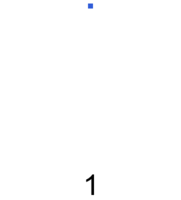Pentagonal Number Theorem

From the previous problems, we have learnt that the Pentagonal Numbers are given by the formula . We have investigated the sequence for positive integers , which gives us the values:
What happens when we substitute in non-positive integers into this formula? We will get a different sequence, namely:
Together, these numbers are called the Generalized Pentagonal Numbers. They appear in the following theorem:
The Pentagonal Number Theorem states that
If we take the combinatorial interpretation of the identity, the LHS is the generating function for the number of partitions of into an even number of distinct parts, minus the number of partitions of into an odd number of distinct parts. By looking at the coefficients on the RHS, the surprising corollary is that this difference is either -1, 0 or 1 always!
The combinatorial proof of the Pentagonal Number Theorem follows a similar argument. It creates a bijection between the number of even parts, and the number of odd parts, and then accounts for the cases where the bijection fails, namely at the values . You can attempt to prove it for yourself, or read the Wikipedia article.
Easy Math Editor
This discussion board is a place to discuss our Daily Challenges and the math and science related to those challenges. Explanations are more than just a solution — they should explain the steps and thinking strategies that you used to obtain the solution. Comments should further the discussion of math and science.
When posting on Brilliant:
*italics*or_italics_**bold**or__bold__paragraph 1
paragraph 2
[example link](https://brilliant.org)> This is a quote# I indented these lines # 4 spaces, and now they show # up as a code block. print "hello world"\(...\)or\[...\]to ensure proper formatting.2 \times 32^{34}a_{i-1}\frac{2}{3}\sqrt{2}\sum_{i=1}^3\sin \theta\boxed{123}Comments
nice
Does it work for n-gon as well? I haven't tried to generalize it yet........
Log in to reply
Does what work for n-gon?
If you're referring to finding the formula for the number of dots in Figure K of an N-gon diagram, then yes you can use similar approaches. The easiest will be to find the Arithmetic Progression, and then find the sum of that. I wanted to show a different approach, which uses the idea of Mathematical Induction, or Method of Differences.
Log in to reply
I meant the number of dots only. Thanks, sir.
Log in to reply
Why don't you investigate and then write up a note? I'd be interested in your results.
great
Greaat :) It was very interesting. Thank you !
it would be always positive integer.
i will continue my thinking unless i will got it. Thanks
Fantastic
Nice one sir! Can I suggest something? Knowing 1st pentagonal number is one, we can see that number of dots to be added to form the next pentagonal number are in A.P. - where a=4, and common difference d=3.... Thus can't we express pentagonal numbers as sums of the increasing A.P. 1,4,7,10; i.e. S1, S2, S3 and so on, where S(n) is the sum to 'n' terms of the A.P. 1,4,7,10...?